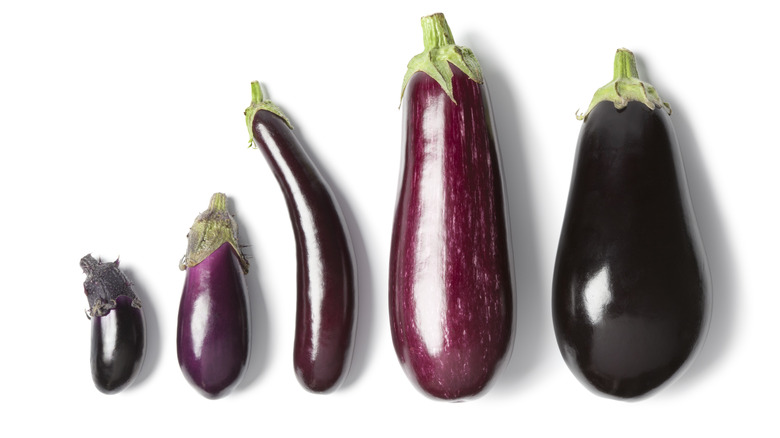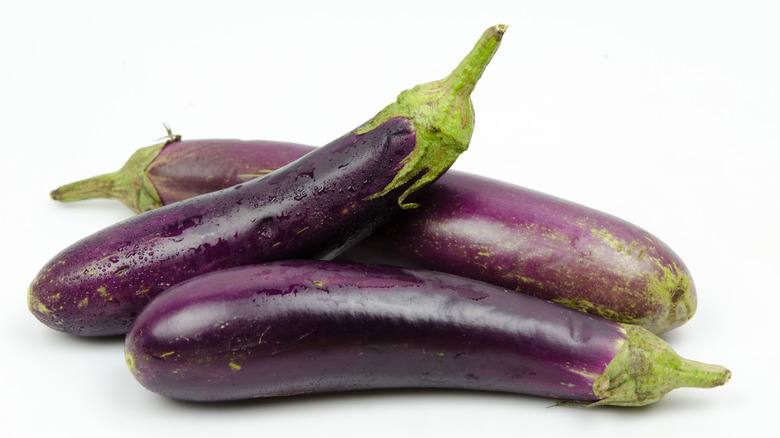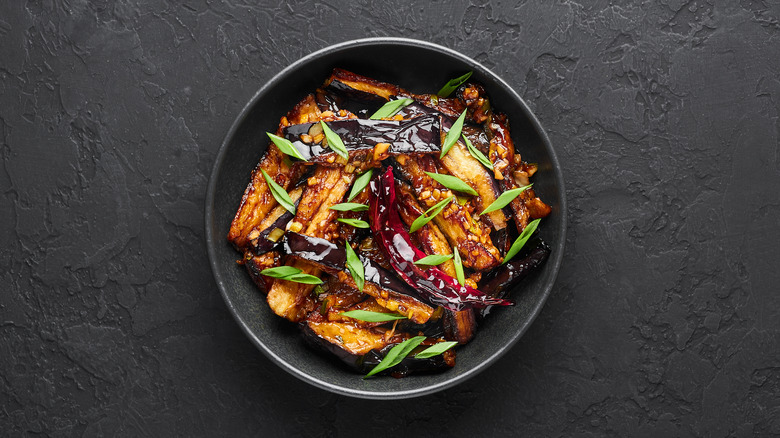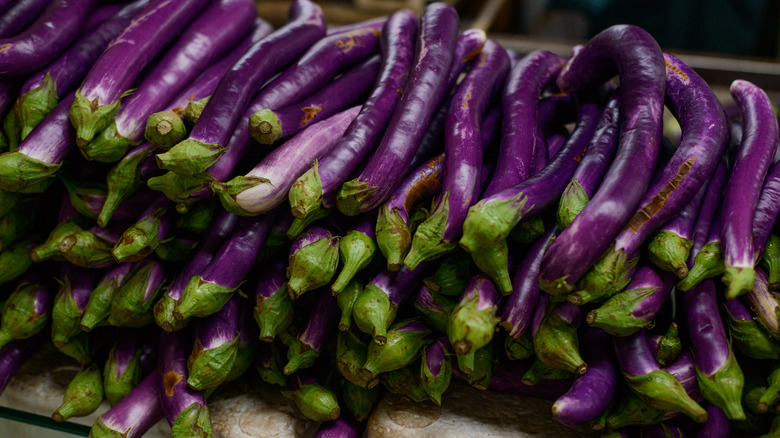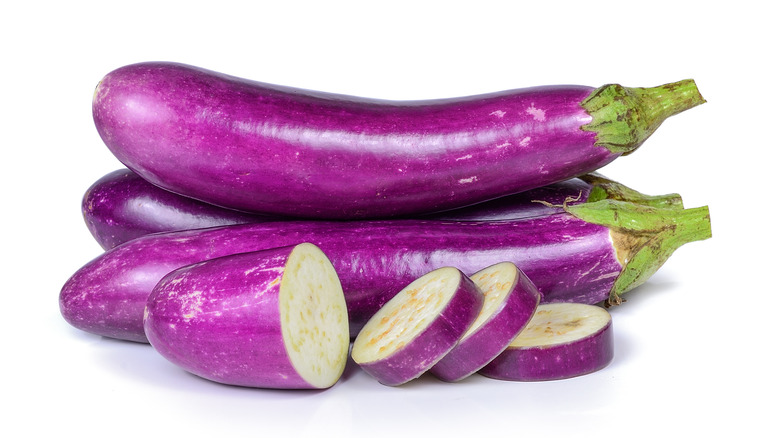How Chinese Eggplants Compare To Other Varieties
Eggplant season is a joyous time; every July through October, produce aisles and farmers' markets are loaded with different varieties. Throughout those glorious four months, your eggplant options expand from the big purple American kind you see all year long to other, more unique varieties of different shapes, sizes, and colors. From the smaller types like the graffiti and the fairy tale to the colorful green, white, and red Turkish eggplants, at the right time of year, your choices are almost never-ending. With distinct flavors and textures all their own, you'd be a miss not to try them all at least once — but if you start your eggplant journey anywhere, start it with the Chinese eggplant.
Available year-round, the Chinese eggplant is a somewhat familiar variety that you've more than likely seen hanging around. Long and lean, its shape is dramatically different from the large American eggplants you may be used to — but it comes with its own advantages. Sporting the same purple skin and green cap, Chinese eggplants are like the American's scrawnier cousin. Just don't be surprised if you catch yourself rooting for the underdog when you get them in the kitchen.
What are Chinese eggplants?
Originating from — you guessed it – China, Chinese eggplants are a product of what's widely known as the top producer of eggplants in the world, producing double the amount of New Jersey, the state that produces more eggplant than any other in the US. However, history also suggests that they were cultivated in India, with manuscripts and atlases documenting their use as far back as the Southern and Northern Dynasties, as well as the Western Jin Dynasty. Scientifically known as Solanum melongena, Chinese eggplants encompass hundreds of varieties, all hailing from China and Asia. They have long been used to ease all kinds of ailments in traditional Chinese medicine — but it's their culinary attributes that have made them widely known and available around the world.
Long and skinny, with thin skin that can range from shades of light violet to bright purple, Chinese eggplants are a distinct variety you can't miss. However, like tomatoes, their respective food group has long been a topic of debate. Everyone wants to know, are they fruits or are they vegetables? While they may not look like it, eggplants — including the Chinese variety — are actually considered berries. Containing small, edible seeds, Chinese eggplants are also members of the Solanaceae family, meaning that they're technically considered nightshades — a category that carries its own controversial history. While most nightshades are poisonous, very few are edible. Luckily, eggplants fall into that bracket.
What do Chinese eggplants taste like?
Just like their unique shapes, Chinese eggplants have a taste that's distinguishable from any other eggplant on the market. For one, they contain a lot fewer seeds than most eggplants. Typically, seeds are what cause uncooked, bulbous American eggplants to taste bitter. But, being virtually seedless, Chinese eggplants tend to taste a lot more mild and sweet. Their seedlessness also translates to their texture, which is cotton white and somewhat firm. Transforming into an extra creamy texture when cooked, Chinese eggplants also tend to be much meatier than others — a good note to take for vegans and vegetarians to take. Their thin skin only makes their texture more enjoyable while still holding them together during the cooking process.
As with any eggplant, there isn't much you can't do when it comes to cooking with the Chinese variety. Only, thanks to their tender flesh, they'll cook up much faster compared to other types of eggplants. Braising, steaming, stir-frying, sautéing, and grilling are all common methods for preparing them. However, it is said that you'll achieve the best texture by baking them. Due to their soft texture, they tend to be featured in dishes like roasts, mashes, and stews. But they're most famous for their starring role in a Chinese take-out classic: spicy garlic eggplant. Similarly, traditional recipes feature Chinese eggplants in cold salads, coated in a subtle spicy sauce, and served either as an appetizer or side.
Where to buy Chinese eggplants
The best part about Chinese eggplants is they're available all over the world. In fact, they're as easy to come by as the American kind — no matter where you live. While they're technically in season from July to October, which is when you're most likely to spot them at your local farmer's market alongside the many other eggplant varieties, they're actually available all year round.
Thanks to their unique shape, Chinese eggplants are easy to spot at the store. Just check out the produce section — there, somewhere among the walls of fresh lettuce, herbs, and peppers, you'll surely find them. Their long, skinny shape tends to stick out next to the large, bulbous American kind, so you shouldn't have a problem there. However, when you do pick one, be sure to go for Chinese eggplants that feel firm without any soft spots for the best results.
Nutrition information
Knowing that they're edible nightshades — as opposed to poisonous ones — it might be comforting to know that Chinese eggplants, and eggplants in general, aren't just delicious but nutritious too. In fact, they've been used in both Chinese medicine and the ancient Indian system of Ayurvedic medicine for thousands of years, easing the symptoms of everything from wounds to diabetes and asthma. Nutritionally, however, eggplants are found to be especially rich in vitamins like folate, potassium, manganese, and vitamins K and C.
With just 25 calories, 1 gram of fat, and a healthy amount of fiber, Chinese eggplants are a simple and nutritious treat — just be cautious when cooking them with oil. Eggplants are like sponges, soaking up all the tasty flavors you add to them. But, they'll also quickly soak up any oils you use, which won't only add to the fat content of your meal but also create a greasy mess. To avoid using too much, it's recommended that you lightly brush each side of your eggplant with oil. You can also try salting or microwaving your eggplant before cooking to draw out any moisture and close up any air pockets that will absorb more of it.
